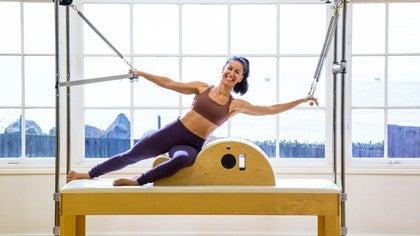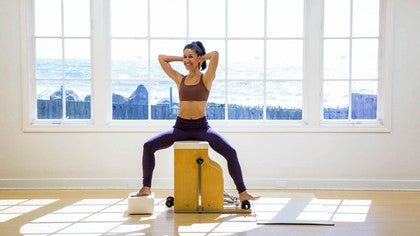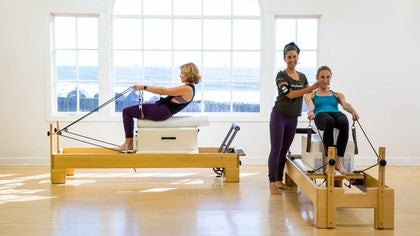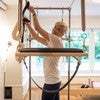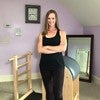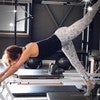Description
About This Video
Transcript
Read Full Transcript
Hi, welcome. So, we're gonna do a little workout on the trapeze table with the spine corrector today that's still focusing on some of the things that we talked about for pelvic floor integration. So, I'm gonna set up the tower bar. I'm going to spring it from underneath, so our safety strap goes on first, and I'm gonna set up with one red and one blue for a little tower footwork. I really like having it heavy.
It just helps me get a little more information into the hips and the spine. If you're having any kind of lower back pain, though, or any situation where you don't feel 100% today, maybe just go with one red spring instead. So, I'm just gonna slide under the bar. Wanna make sure that you're centered, great to use the frame of the tower to do that, and then we'll start with the balls of the feet on the bar in parallel, and we're just gonna press all the way out. And notice that your pelvis is heavy on the mat, and if it isn't, you can always add an extension or bring the chair over so that you can slide out a little further.
And we're just gonna start bending at the knees, and in order to bring them in, the knees will have to turn out, and then extending back out to parallel. We'll just do that about 10 times. And as I'm moving back and forth, I'm really just kind of noticing the glide through my hip. As the knees bend, feeling how the sitting bones move away from each other. As they extend, noticing that sensation goes away, which means that they gently move back into one another.
I'm not squeezing or pulling anything up, just simply observing the sensation of those bony landmarks as I go in and out of the movement. I'll just do that one more time. Then we'll keep the legs straight and we'll do a little flexing and pointing at the ankles. And I love doing the tower bar footwork because I can see my feet, I can notice the alignment, and as I'm pressing into plantar flexion, I'm really noticing how the mound of the big toe is pressing away. Keeping the toes relaxed so that the ball of the foot, or the metatarsal, is really the point that's weight-bearing and the toes don't need to grip.
The heavier springs are also really helpful to get a little more dorsiflexion, maybe, to get that dorsiflexion with a little more ease 'cause I'm letting the spring help to flex my ankles that way. And again, you can do about 10 of each, and then I'll move into running and alternating. And because of the position that we're in, you'll probably find that when your knee bends, you can really feel the crease of your hip a little bit more. If you feel any discomfort or push-back there, just maybe don't bend your knee quite as much. I'm really thinking, on the side that's flexing, that inner thigh is reaching away from me, and again, keeping that awareness of the sitting bones.
Also lengthening away from the head, back of the head and shoulders are relaxed, really allowing the body to accept the support from below. And then we'll straighten both of our legs out and we'll bring our heels, now, onto the bar, and that's going to increase the amount of flexion that I'm in, which, again, if it's available, great, if it's not, just scoot back a little bit more. As we bend the knees, again, we're going to allow them to turn out, maybe come in a little further now, and then extend and roll back into parallel. So, as the knees bend, the thighs turn out. As they extend, they roll back in.
And we're really wanting to find the movement in a way that feels smooth and fluid. So much of it is really just kind of listening to the body so that it feels like it's a flow. As you're bending your knees and this much hip flexion, they'll naturally wanna separate. You just wanna allow that to happen. And you'll notice that the weight kind of rolls to the outer edge of the ankles a bit when you do that, and that's fine.
And on the next one, you'll keep your legs straight and then you'll move your heels out a bit wider. And again, as the knees bend, they'll turn out a little bit, and you might wanna take advantage of that position and just kind of stay there, take a deep inhale, (inhales) and as you exhale, (exhales) visualizing the tailbone energetically reaching away from the head as well as the sacrum moving heavily into the mat. Not because you're pushing, but again, because you're letting go, letting gravity and the springs help to sync things into place. And we'll do that just a couple more times. And again, on the last one, we're going to flex our knees and then just kind of hang out there for a few breaths, allow the knees to spread, let it feel, you know, you're letting your body release as it wants to.
If you feel discomfort, then don't stay there. Push up on the bar, maybe, a little bit more. You will start to feel the work and maybe some heat warming up around the head of the thigh bone, around the front of the hip crease. And again, just take a moment to deepen your breath, allowing the sitting bones to expand out, and then exhaling, lengthening all the way back out to straight legs. Now we're going to bring our heels back in, about shoulder-width apart, and this time, turn the toes and the knees in, bending the knees.
There's probably not a lot of room to do that, so it's a small movement there. Bending the knees, they're moving into each other as if they were going to knock. And on the next one, you'll straighten your legs, turn the knees back out, bend at the knees, and then turn them in, not just to parallel, but rolling in a little bit more. Turning out, bend, turning in, extend. Turning out and bend, last time.
In, extend, and reverse. As the knees bend, they'll roll into each other, then they move out and we extend. You want the movement to feel smooth. Even if it starts to get a little shaky, your intention is to move as if you're moving in water. Just one more this way.
And then we'll extend back out to straight legs, find parallel. Bring the toes onto the bar, and this time, we'll bring our hands overhead to the tower, to the risers, rather, and start to scoot down a little bit. Again, if that's available, and what I mean by that is, if you find that, by extending your arms out overhead, your pelvis is no longer making contact, your sacrum is no longer making contact on the mat, then just keep your elbows bent. Don't go out that far. We'll bring our heels together and point at the ankles.
Again, bend at the knees, inhale, exhale, extending through the legs, and we'll start to peel the pelvis up here. Gently pushing into the arms and into the feet, noticing how you roll through your spine, and then we'll bend the knees at the top and start to curl down. Inhale as the pelvis comes down, extend out through your legs, exhale to peel back up. (exhales) Bending at the knees. Slowly curling down.
(exhales) (inhales) (exhales) Two more. Straighten the legs, send the tailbone towards the sky, like it's traveling up the back of your thighs as you're sending your ribs down into the mat. Come up as high as it feels comfortable and as long as your voice doesn't change too much, so you can always do the talk test. Flexing at the knees and then feeling like your spine is not only articulating, but it's like we're creating space between the vertebrae as we come down. Once the sacrum is down, extend the legs back up, peeling back up from the tailbone, public bone curls back, then the lower back is curling, ribs are curling, really taking the time to go inside and notice what parts of the spine you're moving through as you're moving through them.
Last one. Once that sacrum is down, extending through the legs, and again, peeling back up. I'm feeling little adjustments happening through my hip and my spine. You might notice those little clicks, things falling into place. And then once you've come back down, you'll bend your knees, take the bar, bring your feet down, bring your feet onto the mat and just gently rock from side to side.
And notice a sensation through your back, notice the awareness through the back of your hip sockets now. And if you've never done this on a heavier spring setting, if you always tend to use the same spring, maybe start with a lighter, you know, 'cause the blue is a medium tone tension spring, so maybe start with a yellow or whatever the lightest spring is on your equipment as the second spring you'd add on. And now we're gonna let that movement from side to side get a little bigger, reaching the knee across in a diagonal so that it picks up that area of your ribs and your waist. The outer leg will help bring you back to center, and then you'll switch. And you really want to notice how you move through your feet as you do this.
It's as if you're pushing off your big toe, it sends your hip forward, and that knee wants to reach across in the diagonal. We'll just do that a couple more times on each side. And then coming back to center, bringing one knee in at a time, hug the knees into the chest. With the hands on the knees, we'll just do a few big hip circles here. You really want it to feel like your arms are directing the legs.
The legs might feel a little heavy after the work that they did. We just wanna make sure that the tissues around our spine feel confident, so to speak, they feel relaxed. If that was a lot of new information, even just adding a little bit more tension to something that is familiar, something that you're used to doing can make a really big difference for your tissues, so we wanna make sure that when we get up, they don't freak out. And just keep reversing, every now and then, reversing the direction of your circle. And last time in the opposite direction.
And then we'll rest. We're going to bring our feet down, hands back on the bar, and you're just gonna scoot, slide back one more time. This time, you'll keep your head, neck, shoulders, spine heavy on the mat, feet planted on the mat, inhale. As you exhale, open your fingers up so you're not gripping the bar. The heels of hands are going to press into the bar as you straighten your arms.
Inhale, exhale, and gently bend the elbows. So, notice as you're straightening your arms, relative to that, your breastbone is sliding back into the table, and you might feel that. You might literally feel how your spine, between your shoulder blades, gets heavier into the mat as you're straightening your arms. So, on the next one, keep the arms straight, inhale, and as you exhale, you're going to allow your shoulder blades to come away from the table just a little bit more and then let the bar help to sync the arm bones back into the sockets. And again, shoulder blades pressing.
Keep the back of the head very heavy, keep the neck relaxed. So, you don't wanna push too fast or too far because we don't want, again, the tissues around our spine to find that this is abrasive. We just wanna use the heavier spring to help create the glide through the arm bone. Last one. And then you'll bend your elbows, inhale, and relax.
(inhales) Exhale, last time, straightening the arms out. (exhales) Keep the arms straight, and now this time, float your legs up into tabletop, one at a time. Click the heels together so that the legs feel like they've become a unit, and the weight that we have in our arms helps to kind of communicate the message to the front of the body that we need some tone. It creates the tone for us. Inhale while you're here.
As you exhale, allow the back of your ribs to press down, and you're not only pushing up on the bar, imagine you want the bar to slide towards your knees, and notice that that'll create a little more tone there as well. On the following exhale now, separate the knees a little bit wider, creating a diamond shape through the thighs. And now we'll keep that same angle behind the knee, and as we exhale, our right leg is going to reach towards the ground and come back up, and alternate. So, you don't have to touch the floor. You basically only wanna move the leg as far as you can keep the spine in the same position.
So, noticing that the relationship between your back and the mat doesn't change. Also talking while you do this, making some sound, is a good idea to check in with the pressure. So, if your voice changes, that means that there's a mismanagement of the pressure inside. So, we wanna make sure we're exhaling, that the breath is moving, that there isn't a big, too much of a change. We're able to manage the weight of the legs.
Last one, and then we'll bring our legs back in, click the heels together, bend the elbows, inhale. (inhales) Exhale, extend back through the arms. (exhales) Get empty, empty, empty, inhale while you're here. Push the bar towards your thighs, exhale, both legs moving together now, and slowly drag them back up. Keep the back of the head heavy.
Exhaling to move the legs away, inhaling to bring them back. (inhales) (exhales) (inhales) Last one. (exhales) And we'll rest, we'll bring the knees together. Bring one foot down at a time, bend the elbows, let the arms relax, and let it all fall off, and then gently rocking the knees from side to side. Just let them go all the way to the side, and as you do that, you can start to scoot down a little bit.
We're going to do one last thing before we come up away from the table. So, just wanna scoot down so that I don't have that bar over my face. Once I'm out from under the bar, you'll stop there. Bring your heels pretty close to your bottom and about sitting bones width apart. This time, raise your hands up, interlace your fingers and bring them behind your head.
You'll reach your elbows towards the ceiling, and have that awareness of the breastbone syncing back into the mat as we did with the heavier bar. Inhale while we're here, and as we exhale, feeling the ribs sliding back and starting to lift the head, but yet the head is resting into the hands. Looking through your thighs, and then slowly curling back down and inhale. (inhales) Exhale to curl up by sending the ribs back and feeling the weight of the breastbone wanting to slide back in between the shoulder blades as we curl up. Inhale coming back down.
Last one. (inhales) (exhales) So, I'm not trying to curl up as high as I can, I'm just trying to curl up to that point where I feel the base of my breastbone is really the point of leverage on the mat. And then slowly back down. And now, this time, let your feet come together, let your knees turn out. If it's uncomfortable there, don't let them go as far as you can, always go comfortably.
If you're familiar with letting them flap out and finding the end of your range and that feels good, then that's great. Again, inhale while you're here. Notice, as you inhale fully and slowly, if there's any awareness between that space between your sitting bones. Start to exhale in this position, again, very slowly. Inhaling.
(inhales) (exhales) Exhale all the air out. Notice if you can feel that lift that happens naturally when you really exhale all the air out. Inhale, let your belly expand. Notice if you can feel the movement through that space between the sitting bones again. On the following exhale, (exhales) you'll start to lift your head up when you're about 3/4 of the way done with your exhale.
Lifting, lifting, lifting, lifting, get empty, empty, empty, empty, and then inhale to come back. Let your belly expand. (inhales) Exhale. (exhales) Move through your exhale. Use the movement to squeeze the air out of the lungs. Last one, inhale.
(inhales) (exhales) Notice when you're up here, is there a relationship between what's happening through the back of your throat, through your diaphragm, right under your breastbone, and in that space between the sitting bones? And rest. You can keep the arms up over your head, bring your knees back together, wide as the mat, one last time, rocking from side to side. Alright, and we'll use this little movement to bring ourselves up to sitting, turning to come up to your side, and we're going to take the springs down now. Notice how tall you might feel.
Alright. And now we'll spring the bar from above and we'll grab the spine corrector. Alright, so you want your spine corrector in about the middle of the trapeze table here 'cause we're gonna start off using the tower bar again but we're also gonna use the roll-down bar. So, I've got the roll-down bar sprung with two light springs from the top. And so, you're gonna sit up on your spine corrector and we're gonna bring some of these movements that we just worked on in this supine position up to a seated position where it's a bit more functional 'cause we spend a lot of time in this position.
So, you wanna be careful with these, too, 'cause we don't want the bar to slide out from under your feet. So, you're going to put, not exactly your toes or your metatarsal, it's almost like underneath the ball of your foot or under the metatarsal there, so that you feel like the bird on a perch. But again, it's not so much on the metatarsal the way that usually would be. It's a little bit closer to the center of the foot. So, we're gonna start with a wide position here, and you can just kind of hold on to the back of your thighs just to give yourself that feeling of sitting up really tall, and then allow your pelvis to roll back just a little bit.
So, it's just a smidge, it's not so much where my entire spine is going into flexion. It's just really feeling like, if I had a measure for where my head is, I want my head to stay in the same place as I let my sacrum kind of roll back towards the spine corrector just a little bit. And you'll feel how that turns things on in that lower abdominal, pelvic floor area. So, we'll start to push the bar out, and that's the point where you wanna be careful it doesn't slip out from under your feet, and then we'll bend the knees, and bring it in as close as possible. Inhale, take it out.
Exhale and bring it in. If this feels comfortable, like you're in charge, you can add bringing your hands behind your head, and I'm really trying on the exhale to pull the bar in. (exhales) If I added another spring from the top, it would be a little more helpful to get the bar in, but I want the strength, now, to come from within. I don't want the bar to help me quite that much. If you tend to get cramps in your hips, which is very common, in that case, I would suggest adding an extra spring so that it feels like you can get through that movement and you can get into this tighter range, which is very similar to a squat with a little more support, and then those things that your body tends to do are less likely to happen.
And then you just build up to doing it with the lighter spring. (exhales) Last one. (exhales) Okay. Now we're going to bring our feet together, and again, always be really mindful as you're moving your feet around that that bar doesn't move. We're gonna bring them hip-width apart, and when I say hip-width apart, I'm really thinking the width of those sitting bones that we've been talking about so much.
That far apart. Bend the knees now and kind of push down on the bar as well. And so, you're hugging it in and you're kind of pushing down, release the arms out in front of you, inhale, and as you exhale, you'll start to curl back. Trust your spine corrector. You can bring your hands back behind your head, shoulders wide away from the ears.
If it's not, not every spine corrector is the same, so if you find that your head doesn't reach, you might wanna have a pillow or a ball behind your head anticipating that. Take a deep inhale in this position. (inhales) Exhale first, wait for the exhale. (exhales) As it's moving, you curl up, trying not to move the bar. Inhale when you come up, exhale, extend the legs out.
(exhales) Inhale, bring it in. (inhales) Exhale, keep it still, curling it back. Pushing down into the bar as we reach away. If it feels appropriate, you can extend the arms all the way out. Get a little more distraction through the front of the body.
It feels wonderful, inhale. (inhales) Exhale, scooping the arms out and around. (exhales) Sitting tall. Inhale, we'll do it again. Exhale, curling back.
(exhales) (inhales) Get really long. (exhales) We'll do two or three more of these. There's a lot going on, but try and bring your mind's attention to that space between your sitting bones, your public bone on the front, your tailbone on the back, especially as we move up against gravity. (inhales) (exhales) Notice if you can feel how we don't need to squeeze or even the movement cues the pelvic floor for us. Just breath.
(exhales) Last time. (inhales) (exhales) (inhales) (exhales) And we sit up. Alright. Carefully bring one foot down at a time, take that bar with your hands, bring it up, and we can just take a moment here to be in a wide stance. Push the bar up, let the chest come through, but keep that feeling of your shoulders pressing back and down.
Inhale while you're there, and then exhale and just pull back up to sitting. Let the arms go. Alright, now this time, we're gonna turn to our side and we'll sit in the spine corrector with our hip in the seat. The leg that's off is gonna press back, ball of the foot, again, pushing into the riser, and you'll want your hand on the tower bar, just slightly in front of your shoulder, and we're gonna lean out over the top of the spine corrector, there it is, and grab the roll-down bar. And so, while we're here, we wanna find a way, and you might have to, you know, everyone's height is different and equipments are different, so what we're looking for, basically, is to get the spine in that elongated position, except we're out on this diagonal here.
So, inhale while you're here, shoulders both roll back, and now we're going to exhale and press down into the bar, and then slowly come back up. Inhale. (inhales) Shoulders wide, and I feel like I'm kind of hanging off of the tower bar, exhale to press down, pushing through the back foot, and then bringing it up. (exhales) Just two more. You wanna be really mindful that when you push down on the roll-down bar, you're able to keep that shoulder rolling away from the ear and then you press it down so that we're not creating the feeling of the side of the neck or the upper shoulder working. We wanna feel more of the obliques turning on, (exhales) so you may not pull that far.
Always listen to your body. It might also help to hold the bar from underneath and just direct the elbow down instead, and that's a way to introduce the movement if it's too much to organize for that shoulder in this weird body position. So, this is another way of doing that as well. And we'll just do that one last time, exhaling to pull down and then extending back up, releasing the roll-down bar, and then letting the tower bar help bring you up and taking a little side bend towards it that way, and then we're going to let both of the bars go. And again, we can bring the hands behind the head, and if that feels too heavy, just bring them in front of your chest instead or even just resting on the spine corrector this way.
So, we're gonna slide down first and I'll just break it down. We'll do three or four repetitions, and I'll just break it down from the easier way and then go into the more challenging way. So, to start, you can put your hand behind your head, right hand, or front hand, on the spine corrector, inhale, and as you exhale, initiate by pressing through that back leg, really making sure that you've got that hip extended, then using the hand to push into the barrel to help curl you up, and then lengthening back out. Inhaling, exhaling to come up. (exhales) (inhales) If all is going well, we can progress to both hands, (exhales) and when the hands come away, you'll notice how much more you need that back leg to help create the power.
So, think of pushing through the ball of the foot, pushing the pelvis into arc, and that's what's helping you leverage getting the curl up. Last one. (exhales) And then, again, coming all the way up and extending all the way out. Pushing through that back foot, opening the front of that hip, and then sending the energy up and out through the opposite arm, and coming back. We're gonna turn around now and do the other side.
So, again, that back leg is reaching for the riser there, and then the left hand is just ahead of the shoulder. I stretch and find the roll-down bar, and I'm starting just kind of hanging off of this tower bar, finding that position. And it's always a good idea to check yourself out. If you're not in front of a mirror, just look down, find your alignment. Inhale while you're here.
As you exhale, shoulder rolls down and we press, and slowly back up. (inhales) (exhales) Doesn't matter how far you press the bar down, what matters is that you're able to keep those shoulders wide away from the ears, a long neck. (exhales) Notice if the pressure from the bar travels down through the body. And it might not, and that's okay as long as it doesn't feel like it's creeping up into your neck. Then we'll do a couple where we flip the arm, just to keep things even, where the elbow is directing it, and you're welcome to have done all of them this way.
Exhale as you press, elbow bends, shoulders stay wide, that back foot keeps pressing out. Last one. And then that bar is going to come up and we'll let it go, and then we'll let the tower bar push up, take that little side bend, and then coming back out, draping yourself over the spine corrector. Top hand is on top of it, right hand is behind your head. Inhale while you're here.
Exhale, push with the back foot and the top arm, coming up into that side bend, shoulders stay wide, and then wrapping yourself back around the spine corrector. (exhales) Exhale as you come up, inhale as we go down. (exhales) On the next one, both hands behind the head if that's available, pushing through that back leg even more. (inhales) (exhales) (inhales) Really think of going long as we come down. Again, (exhales) when we articulate the spine, we're also thinking about the whole body getting longer.
(exhales) And one more on this side. (inhales) (exhales) And then coming up and just staying for that stretch. Reaching all the way out and really pushing with that back leg, and then coming back and around. Now, this time, we're going to turn towards the spine corrector. Again, everyone's spine corrector is a little bit different.
So, we're just gonna find the point of balance on the sitting bones. I'm sorry, on the hip bones, front of the hip bones, not the sitting bones anymore. I'm gonna scoot up just a little bit higher. Yeah, so I can really feel the hip bones there, and I know I'm there because I'm able to move my legs now. So, what that tells me is that my sacrum is sufficiently supported into the arc of the spine corrector that I can move in my legs.
And I'm just gonna reach my arms back, turn the thumbs out, squeeze the legs together, inhale (inhales) and exhale. (exhales) Shoulders are wide. Chest is open. Long back of the neck. We're going to challenge this by bringing the arms forward, only as far as you can stay up, and then bring them back. One more time.
Inhale, take them wide. (inhales) Exhale, bring them back. (exhales) Last one, inhale, take them wide, (inhales) exhale, bring them in front of you and let your upper body drape over the front of the arc now. Let your legs release. Inhale while you're here, exhale rolling back up, and just using the support of the spine corrector now to create a little more movement in the upper back. Inhale when you're down. (inhales) Exhale to come up.
(exhales) Last one. (inhales) (exhales) And then we'll bend our knees, you can slide them into the seat, coming up onto hands and knees on here, and just balancing with your knees on the edge there, we'll just use the spine corrector for a second and do a little bit of cat-cow just to free the spine up. I really love doing cat-cow where we lead the extension part from the center of the heart, getting as much movement in that upper back, again, as possible before we let the neck and lower back get involved. Then from there, sending the pelvis under first to get as much flexion in the lower back as we can before we let the upper back and the neck join in. Again, inhale, lead from your heart.
(inhales) Exhale, lead from your tail. (exhales) Last one. (inhales) (exhales) And then sliding off and just settling back into child's pose for a moment. You can rest with your forehead on your hands in the seat. If you need to slide your spine corrector out to get comfortable, do what you need to do, but find the way to use it so that it really helps to get your hips down onto your feet.
And just take a few deep belly breaths while you're here, again, noticing that space between the sitting bones expands as the breath moves in. (inhales) Exhaling slowly, letting everything release. (exhales) Take two more breaths while you're there. (inhales) (exhales) (inhales) (exhales) Alright, and slowly making your way up. Remember that bar is still sprung behind you, so be careful as you come up.
Alright, so that was a little workout to really mobilize your spine, to really get your hips nice and juicy. Motion is lotion, so we really just gave ourselves a very deep hydrating experience. I hope you enjoyed.
Empowered Aging: Pelvic Floor Dysfunction
Comments
You need to be a subscriber to post a comment.
Please Log In or Create an Account to start your free trial.
